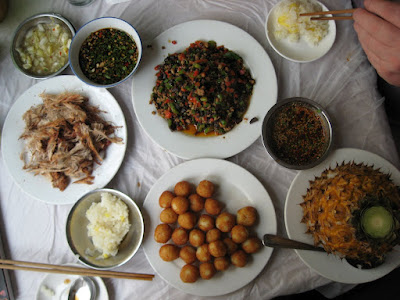China is a huge country, both in population and in geography, and has numerous ethnic communities with their own culinary traditions--there is no one Chinese cuisine.
Still, Peking Duck is an obligatory meal, and we had it twice in my one week visit. I mentioned the first time in a previous post, though I showed only the table. Here's what it looked like from outside:
 |  |

This restaurant was in an amazingly decrepit hutong courtyard, but still attracted upscale clientele. It's not in Lonely Planet, but it's obviously in some guide, as there were three other groups of Westerners when we went. The food was delicious, but they charged extra for bringing more pancakes and sauce, and did not carve the duck in front of us.
Later in the week: a little cheaper, and equally as tasty, the Beijing Guolin Restaurant Liudaokou, across from TB's place, did it right. Picture 3 below shows the, uh, sommelier opening a 78 yuan bottle of baijo. Pricey at USD 11, but it still tasted like fingernail polish--about two steps down from soju. How that's possible remains a mystery to me.



On Friday night, we ate Sichuan, a spicy cuisine at a restaurant so popular among native Beijingers it has become a chain. Named Ba guo bu yi 巴国布衣 in Dongcheng, the entryway looks like this:
 |  |
The ancient courtyard is now used for parking. Our meal, seriously spicy and spectacular, consisted of pork-stuffed lotus root, Shui zhu rou 水煮肉, which literally means 'water boil meat', Suan la tang 酸辣汤, 'sour spicy soup' (tang is also a word for soup in Korean), and at the back there, a bland but tasty eggplant dish.


For lunch on Saturday we ate Yunnan style at a place called Baoqin Dai Ethnic Restaurant 宝琴傣味餐馆. The pineapple at bottom right is filled with sweet rice, and the brown balls are delicately fried mashed potato balls. The strange furry-looking stuff is a shredded, preserved beef which is dipped in sauce and really, really tasty!

We toned down the spiciness at dinner, the star of which was the sliced pork brisket, sage-infused, on the far right.

Street food is standard Asian fare--I remember carrying a bowl out to the soup cart when it rolled by our house back when we lived in Bangkok. And I'm back at it, nearly forty years later. We bought desert waffles from the guy on the left, below. The right photo looks rather like an odeng stall in Seoul.
 |  |
We went to Donghuamen Night Market near the famous Wangfujing Street where grilled food vendors are packed shoulder-to-shoulder. Just like in Korea, food on a stick is symbolized with a Chinese character that looks like a butterfly. Or maybe that's chunks of food on a stick.
 |  |
 |  |

Our last meal together was Chinese hot pot 火锅 (literally 'fire wok') on Monday night in his neighborhood, one of his favorite spots, and I can see why. Koreans also have hot pot and shabu shabu, but this was different from what I've had before. Mainly because of the brown dipping sauce, 麻酱 translated as sesame paste, spicy and fresh-tasting at the same time--since you add chopped cilantro. Did you know cilantro is also known as Chinese parsley and coriander? I did.
Cooking at the table is ordinary in Korea, but this was our only meal of this type. A hole in the table supported the large bowl laden with stock and seasonings: peppers, ginger, etc., as it cooked over a gas ring. Like with shabu, you order ingredients and dump them in to to cook, in stages.


I got the names, Chinese characters and translations from my Man in Beijing, Downtown Tanner Brown. Thanks, kid!










No comments:
Post a Comment